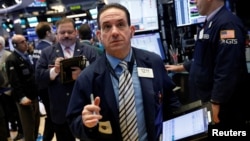U.S. stocks sank in another dizzying day of trading Thursday after U.S. President Donald Trump promised stiff tariffs on imported steel and aluminum, worrying investors about possible retaliation by other countries.
The Dow Jones industrial average fell 420.22 points, or 1.68 percent, to 24,608.98, the S&P 500 lost 36.16 points, or 1.33 percent, to 2,677.67 and the Nasdaq Composite dropped 92.45 points, or 1.27 percent, to 7,180.56.
Trump said his administration would impose a 25 percent tariff on steel imports and a 10 percent tariff on aluminum.
The news took Wall Street by surprise and caused concerns in the markets for companies that rely on aluminum and steel. Shares of Boeing fell 3.5 percent, General Motors dipped 4 percent and Ford dropped by 3 percent.
Large technology companies also suffered, including Apple and Google-parent Alphabet, which fell about 2 percent or more.
But steelmakers rose, with U.S. Steel rising 5.8 percent and Nucor gaining 3.3 percent. Century Aluminum advanced 7.5 percent.
If the tariffs result in higher prices on steel and aluminum, companies that rely on those products may have to pass on some of the costs to consumers. That raises the specter of creeping inflation.
Concerns about trade come at an already shaky time on Wall Street. The S&P 500 and Dow fell about 4 percent in February, their worst month in two years. Fears about inflation and soaring bond yields caused a surge in volatility, including two 1,000-point plunges for the Dow.
Powell's remarks
Stocks had mostly traded lower before Trump's announcement. Federal Reserve Chairman Jerome Powell tried to temper remarks he made on Tuesday that raised concerns about the potential for four interest rate hikes this year rather than the Fed's forecast of three, but New York Fed President William Dudley, speaking in Sao Paulo, Brazil, was a bit more pointed
and said four rate hikes would be "gradual."
But investors said it was the tariff issue that drove the market in its afternoon selloff.
"The risk to imparting these tariffs is that it invites a retaliatory response from our trading partners and particularly China," said Mark Luschini, chief investment strategist at Janney Montgomery Scott in Philadelphia.
Declining issues outnumbered advancing ones on the NYSE by a
1.47-to-1 ratio; on Nasdaq, a 1.42-to-1 ratio favored decliners.
The S&P 500 posted two new 52-week highs and 25 new lows; the Nasdaq Composite recorded 43 new highs and 100 new lows.
About 9.0 billion shares changed hands on U.S. exchanges. That compares with the 8.4 billion daily average for the past 20 trading days.
Some information for this report came from Reuters.





